Following a year in which mineral exploration
budgets plummeted, mostly from
financial strain in the junior company sector,
attendance at the 2010 Prospectors &
Developers Association of Canada (PDAC)
convention and trade show exhibited few
signs of waning interest in exploration
issues. According to PDAC, total attendance
at this year’s annual event was a
record 21,660, surpassing the 2008 convention’s
20,168 attendees, with roughly
1,000 companies participating in either
the trade show or investors exchange.
The show’s robust attendance figures
highlighted an optimistic mood pervading
the industry—not the giddy attitude of the
boom days preceding the 2008 bust, but
more a sense of relief from unfulfilled
expectations that the industry was facing a
long, difficult and uncertain recovery.
Those fears mostly vaporized as 2009 progressed:
by March, commodity prices had
noticeably strengthened, driven by Chinese
demand, and precious metals rebounded.
From late 2008 to late 2009, for example,
gold was up more than 25%, silver more
than 57% and platinum almost 63%.
To be sure, 2009 wasn’t a banner year for
exploration. Metals Economics Group, a
Halifax, Nova Scotia-based firm which tracks
exploration statistics worldwide, reported
planned nonferrous exploration budgets of
the 1,846 companies participating in its
annual survey on corporate exploration
strategies totaled $7.32 billion for 2009—
down from a record $12.6 billion in 2008,
marking the largest one-year decline in the
past two decades. However, despite the deep
cuts to exploration plans, the industry’s
2009 nonferrous exploration budget total
remained well above levels seen prior to
2006, according to MEG. Junior-company
exploration spending fell by more than half in
2009 compared with the previous year, followed
to a lesser degree by intermediate producers—
the result being that exploration
budgets among the major producers stood
atop the heap for the first time since being
overshadowed by juniors in 2004.
The financial blow dealt by the global
economic downturn caused widespread
damage among the juniors, dropping market
capitalization for both the TSX-V mining
sector and the entire TSX-V by more
than half from 2008 levels. However, MEG
attributed the drop in junior-company
exploration spending to a sector-wide cutback
by companies just trying to survive
the slump, citing its data which indicate
the number of juniors actively exploring fell
by only 6% from 2008 to 2009.
A February 25, 2010, report issued by
PriceWaterhouseCoopers Canada detailed
the losses incurred by junior companies
following the economic slump. “In the 12
months ending June 30, 2009, the global
financial crisis eroded the share prices of
most junior mining companies and made it
nearly impossible for many of them to raise
money to finance their projects,” wrote
Paul Murphy, partner and mining industry
leader for PwC. “While some investors were
prepared to take a chance on production
and development companies, exploration
companies, or any company perceived to
carry a higher investment risk, were left out
in the cold.”
As the top 100 TSX-V companies tried to
conserve cash, exploration spending
declined. The top 100 group wrote down a
total of $644 million on mineral properties
and exploration as projects were either abandoned
or put on hold. Stock-based compensation
fell in tandem with share prices and
was 30% lower than the prior year.
Smaller mining companies merged in
order to survive, resulting in a 129%
increase in acquisitions by exploration
companies in the top 100 in 2009.
The PwC report pointed out that cash
available to the junior mining sector dried
up in 2008 and financing became even
more challenging for the top 100 in the
first half of 2009. For the year ended June
30, cash provided by financing activities
(both debt and equity) dropped 21% to
$1.5 billion. Expenses also declined as
companies sought ways to economize.
Of the top 100 companies in 2008, the
PwC report stated that only 48 remained in
the 2009 top 100 list. Most of the remainder
dropped off the list as their market capitalizations
fell, while eight—five of them
gold companies—graduated to the TSX and
another seven were acquired. The 100th
company on the 2009 list had a market
capitalization of $25.7 million in 2009,
compared with $72 million in 2008,
reflecting the serious deterioration in market
conditions for the junior mining sector.
The struggle to survive led to a spike in
the number of mining M&A deals involving
junior companies in 2009. On March 1,
PwC issued a press release noting “the
number of small deals (below US$250
million) was significantly above the prior
three years, with a total of 1,859 deals.
This trend was driven by consolidation of
smaller players and deals driven out of
necessity for survival rather than opportunistic
or strategic growth ambitions.”
Questioning Exploration
Efficiency
The sudden shrinkage of industry exploration
budgets renewed debate over some
broad, ongoing issues: Are companies—
and investors—getting the best bang for a
buck out of their exploration programs?
Overall, how good of a job is the industry
doing in finding new deposits and replenishing
reserves? How can exploration performance,
 One measure of exploration effectiveness is the ratio of reserves to production for any given year, according to
One measure of exploration effectiveness is the ratio of reserves to production for any given year, according to
Michael Doggett, president and COO of HanOcci Mining Advisors. Speaking at PDAC 2010, Doggett presented this
chart to illustrate that the copper industry, for example, despite doubling annual production during the past 30
years, has steadily maintained a reserve base of more than 30 years of production. Source, Doggett, PDAC 2010,
“Measuring Exploration Effectiveness and Efficiency: Do we need to do better? Can we improve?”.
During the period 1979–2008, continued
Doggett, copper reserves in 1979 were
350 million metric tons (mt); in the following
30 years the industry produced 322
million mt, and at the end of the period
reserves were reported as 550 million mt. Exploration during that span resulted in a
net addition of 522 million mt of copper.
To determine the reserve replacement
ratio, he explained, divide net reserve additions
by production:
• For 1979-2008 = 522/322 = 1.6
• Similarly, the reserve replacement ratio for
• 20 years (1989-2008) = 1.9
• 10 years (1999-2008) = 2.0
“We have consistently added reserves
at a rate far exceeding overall production.
Does this look like an industry with a discovery
problem?” said Doggett.
Continuing in the same vein, he said
another simple measure of exploration
effectiveness is the ratio of reserves to production
for any given year. This metric represents
the number of years of output supported
by the current year’s reserves, assuming
no growth in annual output or reserves.
If this metric does not decline over time,
then exploration is effective in both replacing
reserves and sustaining growth trends.
“In spite of doubling annual production
during the past 30 years, we have been
able to maintain a base of more than 30
years of production at current rates moving
forward. Does this look like an industry
with a discovery problem?” Doggett said.
“As an industry we have been highly
effective in replacing reserves through
exploration, but this measure does not say
anything about what it costs to be highly
effective. To do that we need to factor in
the amount of money spent on exploration,”
he said.
During 1979–2008, the global copper
industry spent approximately $22.5 billion
on exploration; over the past 20 years, it
spent $17.7 billion, and over the past 10
years, $10.3 billion.
“We can measure exploration efficiency
by considering how much it cost to add
reserves over time,” he said. “Consider an
efficiency of exploration metric whereby z =
net reserve additions, a = cost of making
additions (exploration expenditure), with
a/z = cost per unit of adding reserves. Thus,
the cost of adding a unit of copper reserves
from 1979-2008 was: $22,540 M / 522
million mt = $43.20/mt ($0.02/lb).”
This calculation shows that over 30
years ($0.020), 20 years ($0.016) and 10
years ($0.016) the industry, in terms of
efficiency, has generally been able to consistently
add copper to reserves for two
cents or less per pound of copper—another
indication of exploration efficiency. In
addition, Doggett said the copper industry
has consistently spent 2%–4% of sales
revenue on exploration, in contrast to the
gold sector, which at times spent more
than 12% of sales revenue on exploration
during the same period.
As for the probability that this efficiency
can be sustained in the future, he suggested
that in recent years exploration
effectiveness and efficiency have been
driven by brownfield additions to reserves
in conjunction with major expansions at
the world’s largest copper mines. For
much of the next decade, this will continue
to be the case. Beyond 2020, however,
the ability to increase reserves and annual
output at known mines is at best uncertain.
The underlying resource base is large
but much of these resources are challenged
by political, economic, social and
technological issues.
Long lead times to find and develop new
mines (on average 20 or more years) restricts the conversion of resources to
proven and probable reserves. To meet
anticipated demand for new primary supply
of copper, the industry can only bank on
brownfield success for so long. New discoveries
are essential. Exploration effectiveness
and efficiency will necessarily decrease
when this crossover point is reached.
“Can the industry do better [in exploration]?”
Doggett questioned. “In the face
of the cumulative impact of billions of dollars
of exploration expenditures in the past
few decades, it is completely unrealistic to
think that we will magically get better at
exploration.” There’s no silver bullet or
panacea on the horizon, he suggested, but
to date, advances in technology and the
cumulative base of knowledge gained from
past exploration have been dependable
factors in keeping up with the relentless
forces of depletion.
Gold: Searching for Reserves
Stephen Enders, director and principal
consultant at Renaissance Resource
Partners, Denver, Colorado, USA, and former
senior vice president of worldwide
exploration at Newmont Mining Corp., presented
a less sanguine view of exploration
performance and expectations—at least
’s point of view.



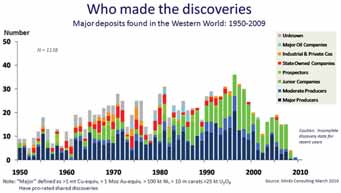 Mineral discovery trends, 1959-2009. Source: Richard Schodde, MinEx Consulting, PDAC 2010, “Global discovery trends 1950-2009: What, where and who found them.”.
Mineral discovery trends, 1959-2009. Source: Richard Schodde, MinEx Consulting, PDAC 2010, “Global discovery trends 1950-2009: What, where and who found them.”.
There’s also a major disconnect in what
major producers want—in terms of exploration
success—and what junior companies
can accomplish, he stated, suggesting
that majors are exploration-phobic and
much prefer to acquire discoveries without
having to spend the time and resources to
conduct their own exploration effort.
Juniors, on the other hand, mainly function
on an extremely short-term financing timeline.
He estimated that only about 30% of
juniors are seriously interested in creating
wealth for others—“the rest are focused on
creating wealth from others.” And, perhaps
50% or more of junior funding “never goes
into the ground. They spend it just keeping
their lights on,” Enders said.
He said the gold business is quite different
from copper—the median gold
deposit size is about 350,000 ounces,
much smaller than typical copper discoveries
and much quicker to deplete. Because
of the difficulty of replacing reserves to
maintain production, he believes that
“from a major’s perspective, [gold] is not a
sustainable business” by itself and that’s
why major gold producers are now focusing
on finding porphyry copper-gold deposits.
Discovery Rate Declines
In the same session, Richard Schodde,
managing director of MinEx Consulting,
Melbourne, Australia, presented results of
a study on global discovery trends from
1950–2009, focusing on how many
deposits were found, what commodities
were involved, where were they found and
who discovered them. The study included
nonferrous metals, precious metals, diamonds,
and uranium but excluded bulk
minerals (coal, iron ore, bauxite) and
industrial minerals such as potash, talc or
phosphate. It also ignored discovery of
satellite deposits feeding into an existing
mill within an established mining camp
(for example, it counted the Ekati diamond
discovery as one world-class discovery, not
20 small discoveries), and limited analysis
to major deposits ( > 1 million mt Cu
equivalent, > 100 kt Ni, > 1 million oz Au,
> 10 million carats, > 25 kt U3O8, etc.). It
also assessed quality of the discoveries
(Tier 1, Tier 2).
The study’s findings, in a nutshell:
• In spite of record exploration expenditures,
the rate of discovery has declined
over the last decade.
° Industry is now finding less than
10–20 major deposits per year.
° Only one to two of these are “worldclass.”
° The gold industry is struggling to replace
the ounces it mines.
• In the last 20 years there has been a steady
shift away from the established countries.
° In the 1980s, Canada, the U.S. and
Australia accounted for over half of
all major discoveries. Now it is less
than 20%.
• Since 1980, the “main game in town”
has been gold.
° Currently 60%–80% of all major
discoveries are gold-related.
° The current hot spots for gold are
Colombia/Ecuador, West Africa and
Central Africa.
° The size and grade of the discoveries
(for gold) is declining.
° Few major lead-zinc, diamond or
uranium deposits have been found
in the last decade.
• Since the 1990s, juniors have played a
significant role in discovery.
° Currently over half of all major discoveries
in the Western World are
made by junior companies and
small producers.
As exploration drilling steadily moves
toward jobs involving deeper deposits in
remote areas, requirements for more powerful
drills, longer-lasting core bits and better
driller accommodations are being met
by industry suppliers.
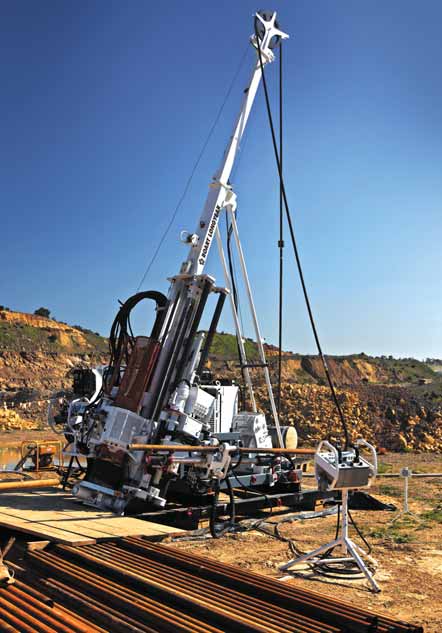 Boart Longyear’s new SC11 flyable exploration drill rig is designed to be transportable in nine to 11 helicopter
Boart Longyear’s new SC11 flyable exploration drill rig is designed to be transportable in nine to 11 helicopter
lifts,
with the heaviest module weighing 680 kg (1,500 lb).
“The SC11 is built from Boart Longyear’s
proven LM technology and designed for use
in surface applications where access is limited
and drill footprint is a critical consideration,”
said Craig Mayman, global product
manager for capital equipment. “It’s
extremely flexible—conveniently assembling
and disassembling in flyable, compact modules—
and in colder regions, its compact size
enables operation inside a drill shack.”
The SC11 was literally built around the
engine—a John Deere 4045HF485, 4.5-
liter, Tier 3 diesel rated at 172 hp (128
kW)—to take advantage of its high power rating.
The SC11 delivers large-diameter and
deep-hole drilling capacity with a 132-kN
pullback rating and PQ handling capacity.
The rig features a variable-speed motor that
provides low-end torque output of 5,456 Nm
at the head for tri-cone drilling and a 1,230-
rpm speed for diamond drilling. The rig also
has efficient hydraulics to easily make or
break rod joints and transport rods safely.
Hydraulic actuators control the rig’s rod
handler, providing movement in three
dimensions. The rod handler has proximity
sensors to protect the operator by preventing
rod drops when operators are nearby. A
laser beam system positioned between the
helper and rod-handler control panel stops
movement when drillers enter the operating
area. Once the beam is interrupted, the
rod handler immediately stops and can
only be restarted when the driller resets it.
The rig uses Boart Longyear’s Nitro
Chuck with gas-charged springs that actuate
the jaws holding the rods to provide failsafe operation. Control panel levers also feature
lift-to-shift rotation and feed actuation
that protect against accidental actuation.
The SC11 has been designed to break
down into flyable modules, with the heaviest
lift weighing 680 kg (1,500 lb), and
depending on drill configuration, it is transportable
in nine or 11 (with skid base and
rod handler) lifts. Lifting points are positioned
at the module’s center of gravity to
provide a balanced load, while quick-connect
hydraulic couplings speed assembly
and disassembly and prevent oil spills. All
modules utilize visible guides to help operators
quickly align and assemble the rig,
speeding up the setup process. Pressed
steel framing with male-female joints help
the modules drop into position and highly
visible jacking and lifting points make
assembly and disassembly safe and easy.
The SC11 is built at Boart Longyear’s
Perth, Western Australia, facilities and
units have been field tested in New
Zealand and Indonesia.
Monika Portman, Boart Longyear’s product
manager for coring products, introduced
two recent developments in the company’s
core-bit lineup. A new XP line of surface-set
bits includes 11 configurations designed to
last up to three times longer than conventional
surface-set bits and eliminate the need
to utilize alternative bits in broken ground.
The company sees the largest market for
these bits in the coal sector.
“Our goal was to redefine the surfaceset
category and set a new benchmark for
productivity in soft and sedimentary applications,”
said Portman. “Early testing of
the new surface-set bits confirms the
strength of the engineering and technology
applied in their development.”
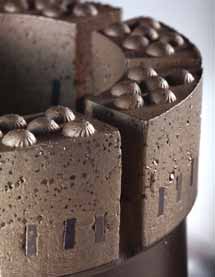 The new Surface Set XP line of bits can provide up to
The new Surface Set XP line of bits can provide up to
three times longer life than conventional surface-set
bits, according to supplier Boart Longyear.
Portman said the bits’ RazerCut face
design further increases productivity by
quickly exposing the impregnated diamonds.
This design, she noted, delivers
“sharp-out-of-the-box” performance, with
exposed cutting surfaces for immediate
drilling capability.
By delivering better cutting and deeper
penetration, the bit’s Ultramatrix design
reduces downtime where the bit is not cutting.
Hard seams often destroy traditional
surface-set bits, forcing operators to pull
the rod string out and change bits if ground
formations vary at depth. The Surface Set
XP bits are claimed to provide a “pushthrough”
capability in hard seams, preventing
unnecessary rod trips and enabling
drillers to keep their string in the ground
longer.
Portman said the company also has
upgraded and expanded its Stage diamond
coring bit product line. The new bits
include engineering upgrades to the
Stage3 waterways, a selection of Stage bits
with an optional new 16-mm crown and an
optional face-discharge feature.
Since its release in 2007, said
Portaman, the Stage3 diamond coring bit
remains the industry’s tallest, with a crown
height of more than 25 mm. Its patented
design is claimed to deliver better penetration
rates, longer active drilling in the hole
and fewer rod trip-outs, increasing shift
capacity and overall meters drilled.
“The new design features an expansion
of our patented window to improve productivity,
a revised window layout to increase
strength and also has our new patent-pending
RazorCut face design. The 16-mm
model includes the upgraded Stage technology
and gives customers more choice
when operating at shallower target depths.”
Upgrades to the Stage design include
windows with rounded corners for greater
durability. The new windows increase
resistance to damage caused by debris in
fractured ground conditions. The windows
also feature a new Twin-Taper design; they
taper inward to create more material on the
window’s inner diameter, increasing material
strength and extending product life. In
addition, the tapered windows produce
high fluid velocity in the inner diameter,
resulting in better flushing of fluids, cuttings
and debris.
Portman said the Stage windows are
now positioned to rotate in the opposite
direction of rod rotation, creating more surface
material which further increases the
strength of the crown and improving performance
in all types of ground conditions.
Excore Bits Enhance Efficiency
Not to be outdone, Atlas Copco also introduced
a line of diamond coring bits during
PDAC, noting that their new Excore bit line
is based on the best features of previously
successful designs, but offers new design
points and matrices to achieve optimized
balance between design and metallurgy.
According to the company, testing of the
bit line before launch was rigorous, with
more than 10,000 m drilled in six different
markets under varying conditions
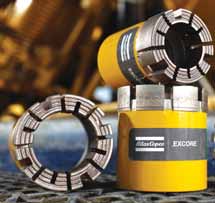 Atlas Copco’s new Excore bit line is available in three
Atlas Copco’s new Excore bit line is available in three
ranges for efficient drilling in soft to very hard rock.
The Excore bit line is divided into three
ranges:
• For soft to medium hard rock with abrasive
and fractured to competent formations
(Matrix series 1-4);
• For medium hard to hard rock with slightly
abrasive and slightly broken to competent
formations (Matrix series 5-8); and
• For hard to very hard rock with competent
formations (Matrix series 9-10).
Each Excore configuration is available
in various crown designs, including
Extended Channel Flush (ECF) for broken
to competent formations, Jet profile for fast
cutting in competent formations, and Face
Discharge (FD) design for extremely broken
and triple tube applications. Combining
these features with different available
crown heights, from 10–16 mm, according
to the company, providews an Excore bit for
every core drilling application.
Atlas Copco provided several case histories
supporting its performance claims for
the Excore line. At Boliden’s Renströmsgruvan
underground mine, for example,
core drilling at the 850-m level is carried
out by Protek Norr AB, a Swedish drilling
contractor. Recent drilling by Protek Norr
has been in a zone in which normal diamond
drill bit life is roughly 100 m, so
when sinking a 900-m-long hole, the driller
must pull the drill string out of the hole
eight times to change drill bits—adding up
to a big loss of productive drilling time.
Atlas Copco’s sales engineer at the mine
suggested a test of an Excore with a Jet profile.
The first Excore drill bit tested had a
service life of 326 m and the best Excore
bit in the test had a life of 347.5 m.
Overall, testing indicated that the average
life of the Excore drill bits was 324 m, more
than three times that of the bits previously
used by Protek in the same formation.
Similarly, South Africa-based drilling
contractor Drillcorp tested Excore bits during
a five-month contract involving 46
holes totaling 20,000 m of core drilling at
a gold mine west of Johannesburg. By the
halfway point of the contract, the contractor
was managing to drill about 30 m per
shift with an average bit life of 60–70 m
while penetrating fractured, troublesome
ground. The contractor tested an Excore
bit, starting in a hole with 250 m left to
finish; normally, a driller would expect to
change bits at least three more times for
that hole, taking at least 6 hours to run the
rods. However, the Excore bit finished the
hole without need of replacement and was
able to drill another 52 m in the next hole.
The first test bit provided 302 m of life—
four to five times the life the contractor had
achieved with previous bits.
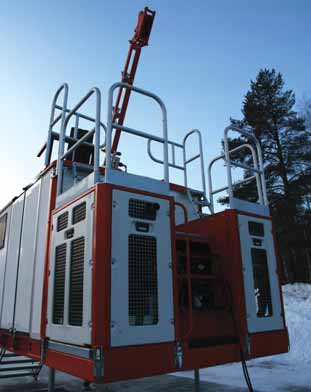 Sandvik’s new, modular drill shack is designed to accommodate its
Sandvik’s new, modular drill shack is designed to accommodate its
DE130
and DE140 drill rigs.
The DE150, introduced in 2009, is
Sandvik’s most powerful exploration rig for
underground exploration. A surface version
of the rig is currently under development,
according to the company, and both versions
share many of the proven components
used by other drill rigs in the DE100
series. In underground applications the
DE150 is equipped with a 110-kW (150-
hp) electric power unit giving a maximum
working pressure of 250 bar (3,645 psi)
and oil flow of 300 l/min (79 gal/min). For
surface application the DE150 will be powered
by a diesel engine. The hydraulic feed
cylinder has a push and pull capacity of 15
mt (147 kN), which is exceptional in relation
to the weight, said Sandvik. Depth
capacity is up to 2,000 m with NQ rods.
The drill unit features a torsion-resistant
steel profile feed boom and a direct
coupled feed cylinder with a feed length of
1,700 mm and maximum feed speed of
0.63 m/s. The feed boom is mounted on a
frame with the tilt cylinder
and mechanical supports.
The mounting frame has
been specifically designed
for quick set-up when fan
drilling, with a full range of
adjustment from vertical
down to vertical up.
Sandvik’s DE150 torque
control enables optimal balancing
of torque and rotation
speed. The control
panel is a pilot-operated
hydraulic system which
gives the operator central
control of all drilling operations
including flush pumps,
wireline hoist and boom tilt.
The system also controls
hydraulic system pressure,
feeding force, hold back
pressure, water pressure and
water flow.
Sandvik also has designed
a drill shack to
accommodate its DE130
and DE140 diamond core
drills. The modular design of
the new Sandvik Drill Shack
makes it suitable for both mobile and stationary
units with quick assembly/pull
down. The drill shack can be packed in
compact units and is suited for helicopter
transportation to remote areas. It can also
be transported in its entirety by tracked
vehicles or mounted on a hook lift frame.
All of the modules needed for operating
the drill shack are built on an identical
platform significantly reducing the number
of components. Modules are fastened to
the floor by T-rail nuts, allowing easy installation,
removal or replacement if needed.
The frame is supported by legs assembled
from the outside and easily removed.
For operator safety, all hydraulics are located
in the frame, keeping the floor free from
hoses and oil leaks. The operator workstation
has a dry, ice-free surface with builtin
floor ducts for heating fluid. The shack's
heating system can be started remotely by
a phone call or by a preset timer. The operator
compartment shares the same heating
system as the rest of the working station,
providing personnel a pleasant working
environment. Sandvik also offers an air
conditioner for applications in sub-tropical
areas. Storage cabinets for coring bits and
tools and a drill pipe stand that can handle
drill pipes up to 6 m are also available
as options.
As featured in Womp 2010 Vol 04 - www.womp-int.com








